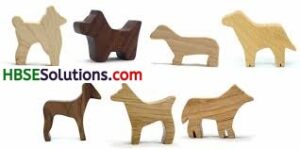HBSE 6th Class Social Science Solutions History Chapter 4 In the Earliest Cities
Haryana State Board HBSE 6th Class Social Science Solutions History Chapter 4 In the Earliest Cities Textbook Exercise Questions and Answers.
Haryana Board 6th Class Social Science Solutions History Chapter 4 In the Earliest Cities
HBSE 6th Class History In the Earliest Cities Textbook Questions and Answers
In the Earliest Cities Question Answer HBSE 6th Class Question 1.
How do archaeologists know that cloth was used in the Harappan civilization?
Answer:
Archaeologists know that the people in the Harappan civilization use cloth because they have found pieces of cloth attached to the lid of a silver vase. They have also found spindle whorls, made of terracotta and faience. They were used to spin thread.
![]()
In the Earliest Cities Class 6 Question Answer HBSE Question 2.
| Copper | Gujarat |
| Gold | Afghanistan |
| Tin | Rajasthan |
| Precious Stones | Karnataka |
Answer:
| Copper | Rajasthan |
| Gold | Karnataka |
| Tin | Afghanistan |
| Precious Stones | Gujarat |
HBSE In the Earliest Cities 6th Class Social Science Question 3.
Why were metals, writing, the wh.ee! and the plough important for the Harappans?
Answer:
(i) Metals: Metals were important for the Harappans, because metals were used for making ornaments and seals.
(ii) Writing: They know the art of writing and their script was pictographic. They used this sign (pictographic script) to convey their idea (message).
(iii) Wheel: Wheel was used for making carts (bullock-carts, ox-carts). It was also used for disigning pottery.
(iv) Plough: Plough was used for digging the earth for turning the soil and planting seed s. Early plough were made of wood.
![]()
LET’S DISCUSS
Question 4.
Make a list of all the Terracotta toys shown in. the lesson. What do you think children would have enjoyed playing with the most?
Answer:
The Terracotta toys shown in the lesson are other Terracotta toys used were dolls, puppets, marbles, whistles, jewellery articles etc. We think children would have preferred toy carts instead of toy ploughs. Girls would have enjoyed dolls and puppets the most.

(a) Toys of dog.

(b) A toy plough.

(c) Toy cart.
Question 5.
Make a list of what the Harappans ate, and put a tick mark against the things you eat today.
Answer:
Harappans ate the following things:
(a) wheat
(b) barley
(c) pulses
(d) peas
(e) rice
(f) sesame
(g) linseed
(h) mustard
(i) fruits like her
We eat almost all the things mentioned in the list today.
Question 6.
Do you think that life of farmers and herders who supplied food to the Harappan cities was different from that of the farmers and herders you read about in chapter 3? Give reason for your answer.
Answer:
Some points of difference between the lives of farmers and herders who supplied food, to the Harappan cities, and those of the previous chapter:
(i) Tools:
Harappan farmers and herders used a wooden tool called plough which was used for turning the soil and planting seeds. The earlier farmers and herders used mortars and pestle for grinding grain. Their tools were also made of bone.
(ii) Irrigation: Harappan farmers and herders used irrigation for better produce while the earlier ones did not.
(iii) Storage: The Harappan farmers stored food in well-built granaries and not in clay pots, baskets, etc.
(iv) Residence:
Harappan farmers lived on the outskirts of cities, whereas there were no settled cities in the time of the farmers and herders in Chapter 3.
![]()
LET’S DO
Question 7.
Describe three important buildings in your city or village. Are they located in a special part of the settlement (e.g. the centre)? What are the activities that take place in these buildings?
Answer:
The three important building in my city, Delhi, are:
(i) Rashtrapati Bhavan: It is the official residence of the President of India.
(ii) Parliament House: Here the elected representatives of the people meet and discuss all important issues regarding the country.
(iii) Supreme Court: It is the highest court of the country where all the cases are decided. The building is called the supreme court building.
Question 8.
Are there any old building in your locality? Find out how old they are and who looks after them.
Answer:
There are many old buildings near my locality. They are
(i) Red Fort
(ii) Jama Masjid
(iii) Ferozeshah Kotla.
Red Fort was constructed in the 17th century.
Jama Masjid was also constructed in the 17th century.
Ferozeshah Kotla was built in the 15th century.
The Archaeological survey of India looks after the ancient buildings
![]()
HBSE 6th Class History In the Earliest Cities Important Questions and Answers
Very Short Answer Type Questions
Question 1.
What is a citadel?
Answer:
Citadel is the higher part of the city. Usually, the part to the west was smaller but higher.
Question 2.
Name some the important site of this culture.
Answer:
The important sites of this culture were Harappa and Mohenjodaro (now in Pakistan) Kalibangan and Lothal (in Rajasthan and Gujarat) respectively.
Question 3.
What was lower town?
Answer:
Lower town was part to the east of Harappan city which was larger but lower.
Question 4.
Where was cotton grown?
Answer:
It was grown at Mehrgarh about 7000 years ago.
![]()
Question 5.
What was done at fire altars?
Answer:
Sacrifices were performed at fire altars.
Short Answer Type Questions
Question 1.
What do you know about the economic life of the people of Harappa Culture?
Answer:
The main occupation of the people of Indus Valley Civilization was agriculture. They grew wheat, barley and rice. Other occupations were animal rearing, the spinning and weaving of cotton and wool. Their most important industry was pottery. Jewellers made wonderful jewellery of gold, silver and stones. There were traders who carried on trade with foreign countries like Egypt and Sumer. Foodgrains were exported to foreign countries and gold, copper and tin were imported from abroad.
Question 2.
Write about the drainage system in the Harappan cities.
Answer:
Many of the cities had covered drains. They were carefully laid down in straight lines. Each drain had a gentle slope so that the water could flow through it. Very often drains in the houses were connected to those in the streets and smaller drains led into bigger ones. As the drains were covered, inspection holes were provided at intervals to clean them.
Question 3.
Write how were the fields cultivated by the farmers?
Answer:
Farming:
(i) A new tool, the plough was used to dig the earth for turning the soil and planting seeds. The plough was made of wood.
(ii) As this region does not receive heavy rainfall, some form of irrigation may have been used. This means water was stored arid supplied
to the fields when plants were growing.
Question 4.
List at least two differences between the houses of the Harappa and the earlier houses.
Answer:
In Harappa, the house were either one or two storeys high, with rooms built around a courtyard. Most house had a separate bathing area and some had wells to supply water.
Earlier house:
The archaeologists have found the remains houses Mehrgarh, a site in the fertile plain, near the Bolan Pass. Here the houses were either square or rectangular in pattern. Each house had four or more compartments, some of them may have been used for storage.
![]()
Long Answer Type Questions
Question 1.
Describe the people living in the Harappan cities.
Answer:
There were mainly the following kinds of people living in Harappan Cities:
Rulers : They were people who planned the construction of special buildings in the city. They sent people to distant lands to get metal, precious stones, and other things that they wanted.
Scribes: Scribes were people who knew how to write. They prepared seals and also wrote on the other things that have not survived.
Crafts-persons: They were people who made all kinds of things. Besides, there were other people who were farmers or herders.
Question 2.
What factors indicated that Harappan culture was declining around 3900 years ago?
Answer:
The following factors indicated that Harappan culture was declining:
(а) People stopped living in many of the cities.
(b) Writing, seals and weights were no longer used.
(c) Raw materials brought from long distances became rare.
(d) The garbage was found piled up in the streets of Mohenjodaro.
(e) The drainage system broke down.
(f) The new, less impressive houses were built, even over the streets
![]()
Question 3.
What were the factors responsible for the decline of the Harappan City?
Answer:
(i) Floods: Some historians say that regular floods destroyed the Indus Valley Civilization.
(ii) Epidemic: Some historians think that an epidemic might have killed that people.
(iii) Change in Climate: Some other historians say that rapidly the climate began to change and the region became dry like a desert.
(iv) Attacked by the Aryans or some other people: Historians believed that Aryans or some other people attacked the Harappan cities and destroyed them.
(v) Loss of Control: Rulers might have lost control. Consequently, people abandoned sites in Sind and Punjab and moved to newer, smaller settlements to the east and the south.
Question 4.
How was Harappa discovered?
Answer:
Nearly a hundred and fifty years ago when railway lines were laid down for the first time in Punjab, engineers found the site of Harappa in present Pakistan. They thought, it was a big mound, which was a source of ready made, high quality bricks. So they carried off thousands of bricks from the walls of old buildings of the city to build railway lines.
Then about eighty years ago, archaeologists found the site and realised that it was one of the ancient cities in the subcontinent. As this was the first city to be discovered, all other si ties from where similar buildings were found were described as Harappan. The cities developed about 4700 years ago.
![]()
In the Earliest Cities Class 6 HBSE Notes
- Civilization: That stage of man’s development when he used to live in cities and looks for more than just the satisfaction of material needs.
- Culture: Develpoment of the body, mind and spirit by training and experience. It also includes the development of arts, science etc., in human society.
- Citadel: Fortress for protecting a town place of refuge or safety.
- The Harappan Culture: The culture which existed in Sindh, Punjab, Northern Rajasthan and Gujarat. It is also known as Indus Valley Civilization, after the principal river of the region.
- Pictographs: Pictures like signs to represents letters or words.
- Seal: A stamping tool made of clay with a design on one side.
- Four Valley Civilizations: Indus Valley Civilization, the Egyptian Civilization. The Chinese Civilization and the Sumerian Civilization.
- Lothal: The port from where the Harappan traders shipped their merchants.
- The Great Public Bath: The best known building in the Harappan citadel.
- Grainaries: Grain was stored in grainaries.
- Pillared Hall: Hall whose roof stands on pillars.
- Dockyard: An area where ships are loaded and unloaded and place also used for repairing ships.
- Grid System: Intersection of roads at right angle to each other.
- Outskirts: A part of city that is further away from its centre.
- Decipher: It means to make out of meaning.
- Armlets: Ornament wear in the arm known as armlets.
- Idol: Image which used for worshipping, and their worship is called as an idol-worship.
- Terracotta: Hard and reddish brown baked clay is called Terracotta.
- Faience: Artificially produced gum used to shape sand or powdered quartz into an object
HBSE 6th Class Social Science Solutions History Chapter 4 In the Earliest Cities Read More »